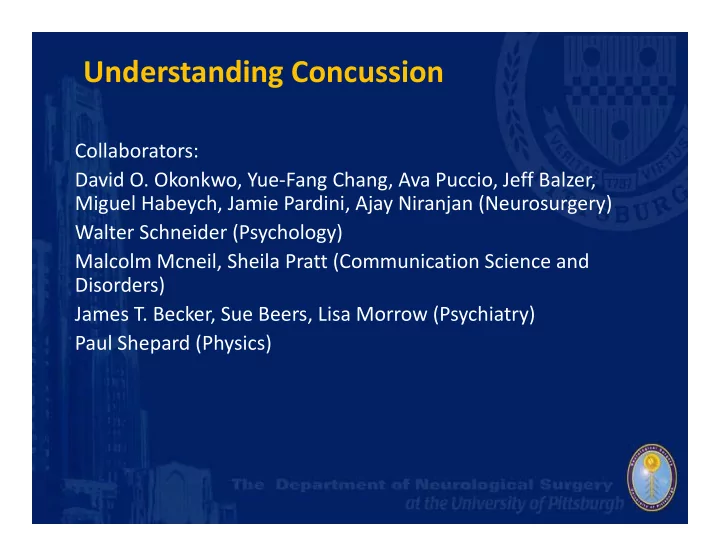

Understanding Concussion Collaborators: David O. Okonkwo, Yue ‐ Fang Chang, Ava Puccio, Jeff Balzer, Miguel Habeych, Jamie Pardini, Ajay Niranjan (Neurosurgery) Walter Schneider (Psychology) Malcolm Mcneil, Sheila Pratt (Communication Science and Disorders) James T. Becker, Sue Beers, Lisa Morrow (Psychiatry) Paul Shepard (Physics)
The Referee Consensus Solver 1. Properties Our primary effort is to understand the changes in brain function caused by concussion.
The Referee Consensus Solver 1. Properties Our primary effort is to understand the changes in brain function caused by concussion. We record the magnetoencephalogram (MEG) during a variety of tasks.
The Referee Consensus Solver 1. Properties We have discovered a new way to extract localized high fidelity neuroelectric recordings from the MEG, referee consensus processing.
The Referee Consensus Solver 1. Properties The processing requires ≈ 50 cpuHours per second of recorded MEG data.
Inside the liquid helium dewar is an array of 102 1”x1” chips, each with 3 magnetic field sensors. Hence the 3D “shape” of the magnetic field around the head is sampled at 102 points .
This 3D snapshot of the “shape” of the magnetic field is obtained 1000 times per second. Each snapshot is a set of 306 measurements at a particular time and is designated: M t
This 3D snapshot of the “shape” of the magnetic field is obtained 1000 times per second. Each snapshot is a set of 306 measurements at a particular time and is designated: M t The referee consensus solver uses 80 snapshots at a time.
Given a specific location in the brain, X, the referee consensus cost function is used to determine if an electric current at X is contributing significantly to the shape of the magnetic field.
Given a specific location in the brain, X, the referee consensus cost function is used to determine if an electric current at X is contributing significantly to the shape of the magnetic field. As part of this determination the procedure produces a high fidelity estimate of the time course of the electric current at X .
We can represent the true 80 ‐ point time course of the current at X as a vector in an 80 ‐ dimensional space.
We obtain an estimate of that time course from the “point of view” of R , a location at a distance from X, a “referee.” We will combine estimates from many referees to (1) decide if a non ‐ zero current is present and (2) what its time course is, hence the name: “referee consensus.”
We now pick X’ , a point which is at 1 mm distance from X .
The referee consensus cost function calculation … … provides a statistically powerful “goodness of fit” measure.
The referee consensus cost function calculation … … produces sufficient signal/noise enhancement to enable source identification and accurate time course measurement from single trial data.
The referee consensus cost function calculation … … isolates one source from all others, enabling identification and time course measurement of one source at a time …
The referee consensus cost function calculation … … isolates one source from all others, enabling identification and time course measurement of one source at a time … … this makes the method most similar functionally to Equivalent Dipole Source Localization.
Recommend
More recommend